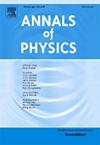Insights of traversable wormhole geometries under complexity factor and different equations of state in modified gravity
IF 3
3区 物理与天体物理
Q2 PHYSICS, MULTIDISCIPLINARY
引用次数: 0
Abstract
The focus of this investigation is to check whether charged traversable wormholes exist in the realm of gravity. Considering the Morris–Thorne spacetime, we develop the wormhole geometry and derive the gravitational equations representing anisotropic fluid setup. To fulfill the objective of this study, we further assume a couple of equations of state to determine some necessary parameters linked with the wormhole models. This leads us to see that this cosmic fluid might provide an interesting explanation for the phenomenon of wormhole geometries. By employing both equations of state, we deduce the shape functions and analyze their consistency by satisfying fundamental conditions. We observe that the resulting functions meet key criteria and link two regions of spacetime that converge to asymptotic flatness. Afterward, we examine their practicality by checking if they violate or comply with the null energy conditions. In addition to that, we study the gravitational mass, complexity factor, embedding diagrams, and the volume integral quantifier. The results of this investigation imply that the constructed wormhole solutions adhere to the essential criteria, permitting their existence in the modified gravity under the considered standard model.
修正重力下复杂因子和不同状态方程下可穿越虫洞几何形状的认识
本研究的重点是检查在f(R,Lm,T)引力域中是否存在带电可穿越虫洞。考虑莫里斯-索恩时空,我们建立了虫洞几何模型,并推导了代表各向异性流体设置的引力方程。为了实现本研究的目标,我们进一步假设了几个状态方程,以确定与虫洞模型相关的一些必要参数。这让我们看到,这种宇宙流体可能会为虫洞几何现象提供一个有趣的解释。利用这两种状态方程推导出了形状函数,并在满足基本条件的情况下分析了它们的一致性。我们观察到所得到的函数满足关键准则,并连接两个收敛于渐近平坦的时空区域。然后,我们通过检查它们是否违反或符合零能条件来检验它们的实用性。除此之外,我们还研究了引力质量、复杂性因子、嵌入图和体积积分量词。这项研究的结果表明,构建的虫洞溶液符合基本标准,允许它们在考虑的标准模型下的修正重力下存在。
本文章由计算机程序翻译,如有差异,请以英文原文为准。
求助全文
约1分钟内获得全文
求助全文
来源期刊

Annals of Physics
物理-物理:综合
CiteScore
5.30
自引率
3.30%
发文量
211
审稿时长
47 days
期刊介绍:
Annals of Physics presents original work in all areas of basic theoretic physics research. Ideas are developed and fully explored, and thorough treatment is given to first principles and ultimate applications. Annals of Physics emphasizes clarity and intelligibility in the articles it publishes, thus making them as accessible as possible. Readers familiar with recent developments in the field are provided with sufficient detail and background to follow the arguments and understand their significance.
The Editors of the journal cover all fields of theoretical physics. Articles published in the journal are typically longer than 20 pages.
 求助内容:
求助内容: 应助结果提醒方式:
应助结果提醒方式:


